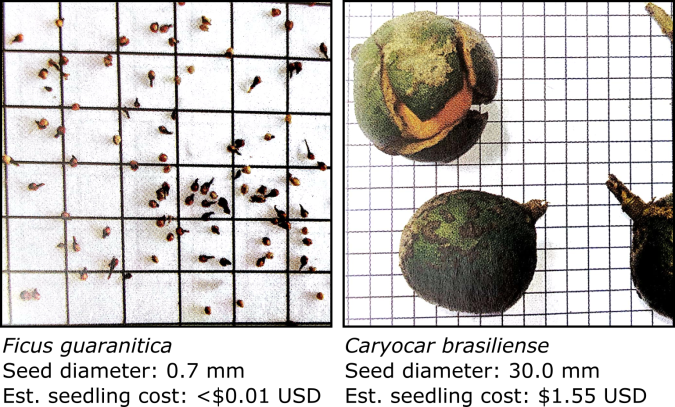A collaborative research project involving MBG’s Center for Conservation and Sustainable Development, the Tropical Silviculture Lab at the University of São Paulo, and the PARTNERS research coordination network highlights important differences between the native tree flora of the Brazilian Atlantic Forest and the species that are widely planted for ecological restoration projects.The Brazilian Atlantic Forest is a global biodiversity hotspot. This designation denotes two things. First, the Atlantic Forest is exceptionally and uniquely biodiverse. Second, the biodiversity of the Atlantic Forest is exceptionally threatened. This once-vast biome historically stretched from northern Argentina to Brazil’s eastern tip in Rio Grande do Norte, but it is now reduced to about 12% of its original size, and most of what remains exists as small, isolated fragments.
During the past decade, a major, multilateral effort has been undertaken to staunch biodiversity loss by doubling the size of the Atlantic Forest through ecological restoration. The Atlantic Forest Restoration Pact is composed of more than 270 private companies, governments, NGOs, and research organizations. It aims to restore 15 million hectares of Atlantic Forest by 2050.

The
Atlantic Forest biome: a global biodiversity hotspot and the site of
the most ambitious tropical
forest restoration project on the planet.
Map imagery from NASA via Wikimedia Commons.
Dr. Pedro Brancalion is a professor at the University of São Paulo’s agricultural school in Piracicaba, Brazil, where he co-directs the Tropical Silviculture Lab. Five years ago, he approached me at a meeting of the Society for Ecological Restoration in Madison, Wisconsin, and over a beer he told me about a dataset that he thought could shed light on the how well Atlantic Forest restoration projects were conserving tree biodiversity. The dataset consisted of seedling donation records from the NGO SOS Mata Atlântica. Between 2002 and 2015, the NGO donated more than 14 million tree seedlings to 961 restoration projects. By comparing the species composition in these records to tree species living in mature forests, we could see what elements of biodiversity might be missing and how this could be affecting carbon stocking – an important factor in mitigating global climate change.
Even in high diversity plantings, many of the most threatened tree species were not included.
Last month, Pedro and our collaborative team published a paper in Conservation Letters describing our results. We found that restoration projects in the Atlantic Forest biome had included 416 tree species out of the >2,500 tree species known from mature and old-growth forest fragments. This is an impressive figure, but the team discovered that it reflects a highly biased subsample of the Atlantic Forest tree flora. The most under-represented species were those with large seeds that are dispersed by animals. Animal-dispersed trees make up as much as 89% of tree species in some parts of the Atlantic Forest and include some of the most threatened species.
The reason that large-seeded, animal-dispersed species are being used less often was probably related to the cost and challenges of collecting and growing seeds. Large-seeded, animal-dispersed trees are more expensive to purchase from nurseries than small-seeded or wind-dispersed species. Because they are energetically expensive to produce and are contained within large fruits, trees tend to produce large seeds in relatively low quantities, with just one or a few seeds per fruit. They are generally found in remote forest areas, and seed collectors have to compete for them with seed-eating animals, like peccaries and agoutis. Once large seeds are collected, they also take up considerably more space in storage and production facilities.

In
our analysis of animal-dispersed tree species, seed diameter explained
87% of the variance in
seed price. Large seeds like those of Caryocar brasiliense were much more
expensive than small ones, like Ficus guaranitica.
Grid size: 1 mm. Photos reproduced from C. N. Souza Junior & P. H. S. Brancalion (2016).
seed price. Large seeds like those of Caryocar brasiliense were much more
expensive than small ones, like Ficus guaranitica.
Grid size: 1 mm. Photos reproduced from C. N. Souza Junior & P. H. S. Brancalion (2016).
Large-seeded tree species also tend to store carbon more densely than small-seeded species. This tendency is related to large-seeded species growing slowly in the shady understory of the Atlantic Forest and their gradual formation of dense wood, which is rich in carbon. We simulated potential carbon stocking in restored forests and compared it to mature forests, and our results showed that under-representation of large-seeded, animal-dispersed trees could cause a 2.8-10.6% reduction in carbon storage. Based on the current price of carbon, this loss could represent $17-63 USD per hectare in lost carbon credits.

Many
Atlantic Forest restoration projects are quite isolated. A large seed
would have a hard time
reaching sites like this forest in a sugarcane matrix. Photo by Pedro Brancalion.
reaching sites like this forest in a sugarcane matrix. Photo by Pedro Brancalion.
For example, new policies could help bridge the gap between Brazil’s exceptional tree biodiversity and the relative paucity of species being used for ecological restoration. One way this could happen would be for the Brazilian government to subsidize the cost of producing large-seeded, animal-dispersed tree seedlings. This could be done through financial incentives or potentially by opening some forest reserves for seed harvesting, to make it easier for collectors to acquire these species. Facilitating uptake by reducing costs would be a carrot. A stick could be to legally mandate some representation of these species in future restoration plantings.
Market solutions may also exist. Based on our calculations, adding more large-seeded, animal-dispersed species to restoration plantings would increase carbon storage and carbon credits, offsetting the cost of the expensive seedlings and creating a net gain of $3-32 USD per hectare.
Banner image: Sterculia striata (Malvaceae). Photo by Mauricio Mercadante. CC BY-NC-SA 2.0.